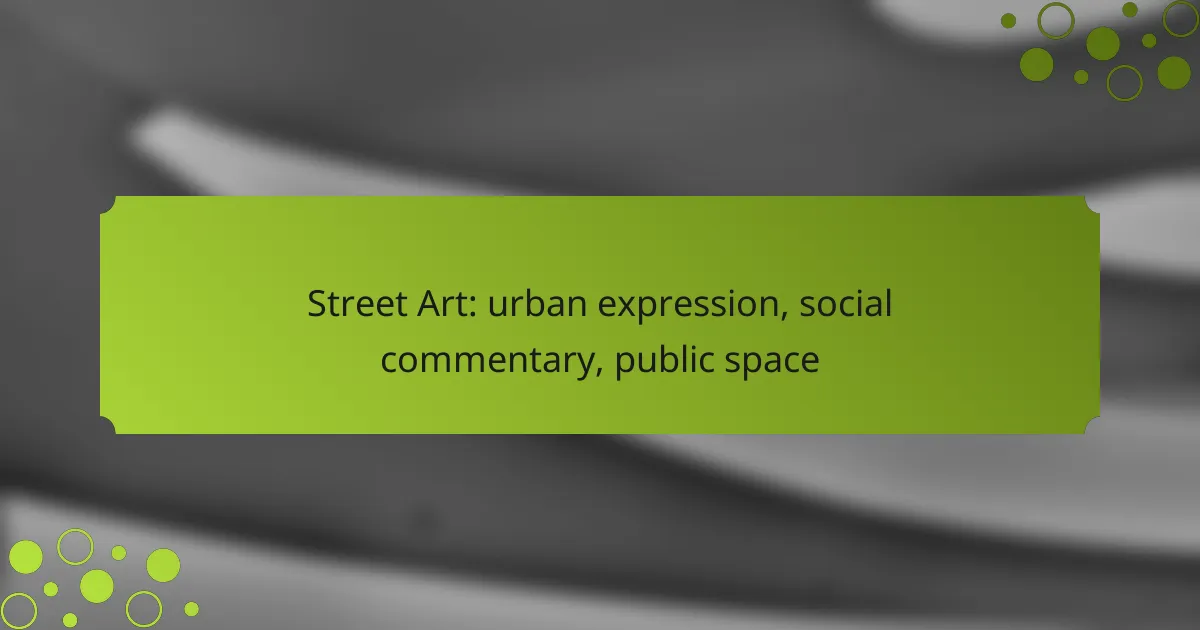Street art is a dynamic form of urban expression that transforms public spaces into vibrant canvases for social commentary and cultural dialogue. By addressing themes such as social justice and environmental awareness, it fosters community identity and encourages public engagement, making neighborhoods more inviting and thought-provoking. This art form not only beautifies urban landscapes but also challenges societal norms and inspires meaningful conversations among diverse audiences.
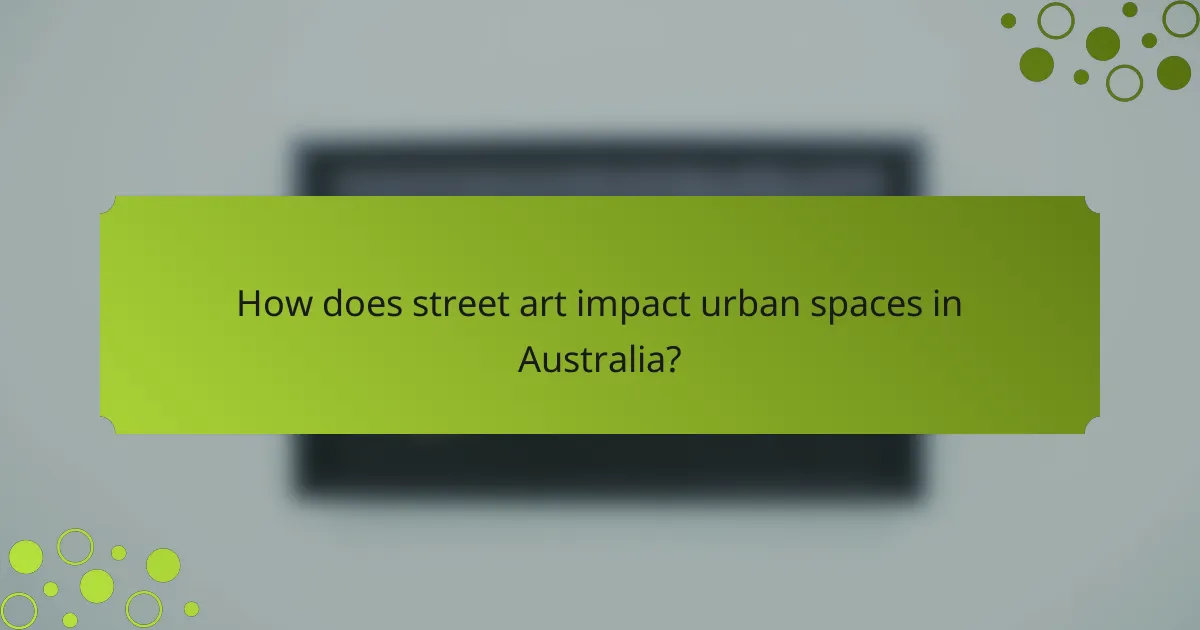
How does street art impact urban spaces in Australia?
Street art significantly transforms urban spaces in Australia by fostering community identity, attracting tourism, and encouraging public engagement. This form of expression not only beautifies neighborhoods but also serves as a platform for social commentary and cultural dialogue.
Enhances community identity
Street art plays a crucial role in enhancing community identity by reflecting local culture and values. Murals and graffiti often showcase the history, struggles, and aspirations of the residents, making the art a source of pride. For instance, in suburbs like Fitzroy in Melbourne, vibrant street art captures the area’s eclectic spirit and artistic heritage.
Moreover, community-led projects can create a sense of ownership among residents. When locals participate in the creation of street art, it fosters connections and strengthens community bonds, making public spaces more inviting and representative of the people who inhabit them.
Attracts tourism and local business
Street art can be a significant draw for tourists, leading to increased foot traffic and economic benefits for local businesses. Areas known for their street art, such as the laneways of Melbourne, often see a rise in visitors seeking to experience the unique urban landscape. This influx can boost sales for nearby cafes, shops, and galleries.
Local governments may also recognize the economic potential of street art and support initiatives that promote it. By organizing street art festivals or tours, cities can enhance their appeal as cultural destinations, encouraging both domestic and international tourism.
Encourages public engagement
Street art encourages public engagement by sparking conversations around social issues and inviting community interaction. Many artworks address themes like inequality, environmental concerns, and cultural diversity, prompting viewers to reflect on these topics. This dialogue can lead to greater awareness and activism within the community.
Additionally, interactive street art installations, such as those that incorporate augmented reality or encourage viewer participation, further engage the public. These experiences can transform passive observers into active participants, fostering a deeper connection to the urban environment and its artistic expressions.

What are the key themes in street art?
Key themes in street art often revolve around social justice, cultural identity, and environmental awareness. These themes serve as powerful vehicles for urban expression and social commentary, allowing artists to engage with the public and provoke thought in shared spaces.
Social justice and activism
Street art frequently addresses social justice issues, using public spaces to highlight inequalities and advocate for change. Artists often create pieces that reflect movements such as Black Lives Matter or [censured] rights, aiming to raise awareness and inspire action.
For effective social commentary, artists should consider the local context and community sentiments. Engaging with local activists can enhance the impact of their work and ensure it resonates with the audience.
Cultural expression and identity
Cultural expression in street art showcases the diverse identities within urban environments. Artists often draw from their heritage, using symbols and styles that reflect their backgrounds, which fosters a sense of belonging and pride among community members.
To effectively convey cultural identity, artists can incorporate traditional motifs or local languages into their work. This not only honors their roots but also educates the broader public about different cultures and histories.
Environmental awareness
Environmental themes in street art focus on raising awareness about ecological issues, such as climate change and pollution. Artists use their platforms to advocate for sustainability and encourage community action toward environmental stewardship.
Incorporating natural elements or using eco-friendly materials can amplify the message. Artists should consider collaborating with local environmental organizations to strengthen their impact and reach a wider audience.
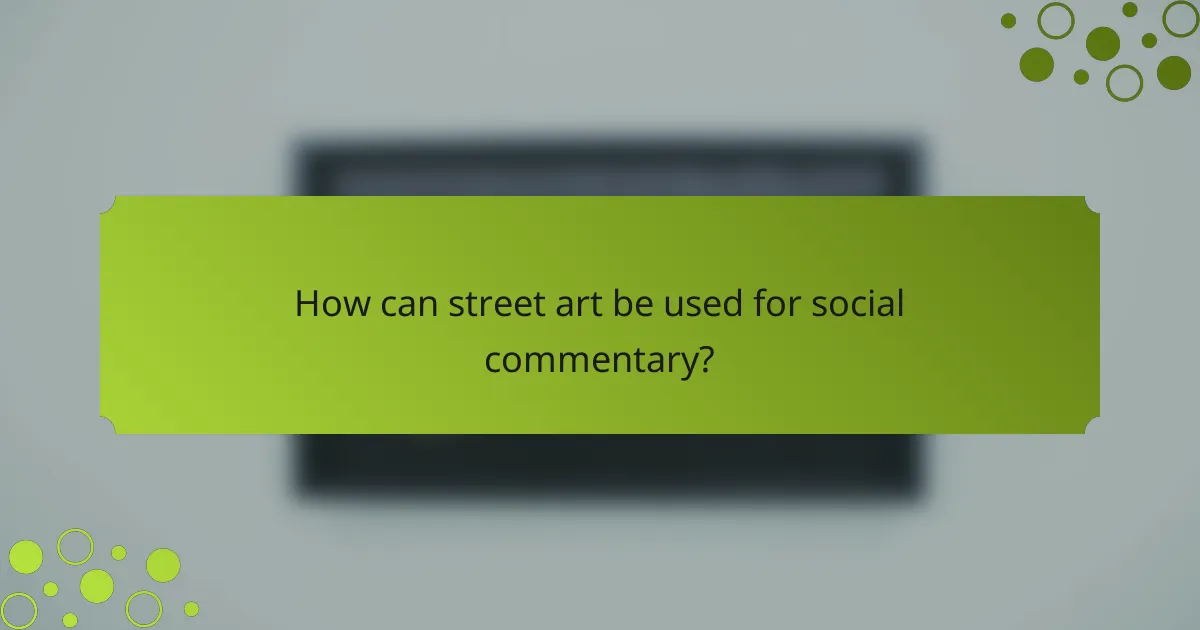
How can street art be used for social commentary?
Street art serves as a powerful medium for social commentary, allowing artists to express opinions on various societal issues directly in public spaces. By transforming urban environments into canvases, street art can provoke thought, inspire dialogue, and challenge the status quo.
Addressing political issues
Street art often tackles political themes, providing a voice to marginalized communities and highlighting governmental failures. For instance, murals depicting protests or political figures can spark conversations about democracy, freedom, and human rights. Artists may use satirical imagery to critique policies or leaders, making complex political issues accessible to a broader audience.
In many cities, street art has become a form of resistance, particularly in regions facing oppressive regimes. The visibility of these artworks can galvanize public opinion and encourage civic engagement, making art a catalyst for change.
Highlighting social inequalities
Street art can effectively shine a light on social inequalities, such as poverty, racism, and gender discrimination. Artists often create pieces that reflect the struggles of underrepresented groups, using striking visuals to communicate their messages. For example, murals that depict the realities of homelessness can evoke empathy and raise awareness among passersby.
By placing these artworks in high-traffic areas, artists can reach diverse audiences, prompting discussions about systemic issues that may otherwise go unnoticed. This public engagement can lead to increased advocacy and support for social justice initiatives.
Promoting mental health awareness
Street art plays a significant role in promoting mental health awareness by addressing stigmas and encouraging open conversations. Murals that feature uplifting messages or portray mental health struggles can resonate with individuals facing similar challenges. This visibility helps normalize discussions around mental health, making it easier for people to seek help.
Artists may collaborate with mental health organizations to create pieces that provide resources or support information, effectively using public art as a tool for community healing. By fostering a sense of connection and understanding, street art can contribute to a more supportive environment for those dealing with mental health issues.
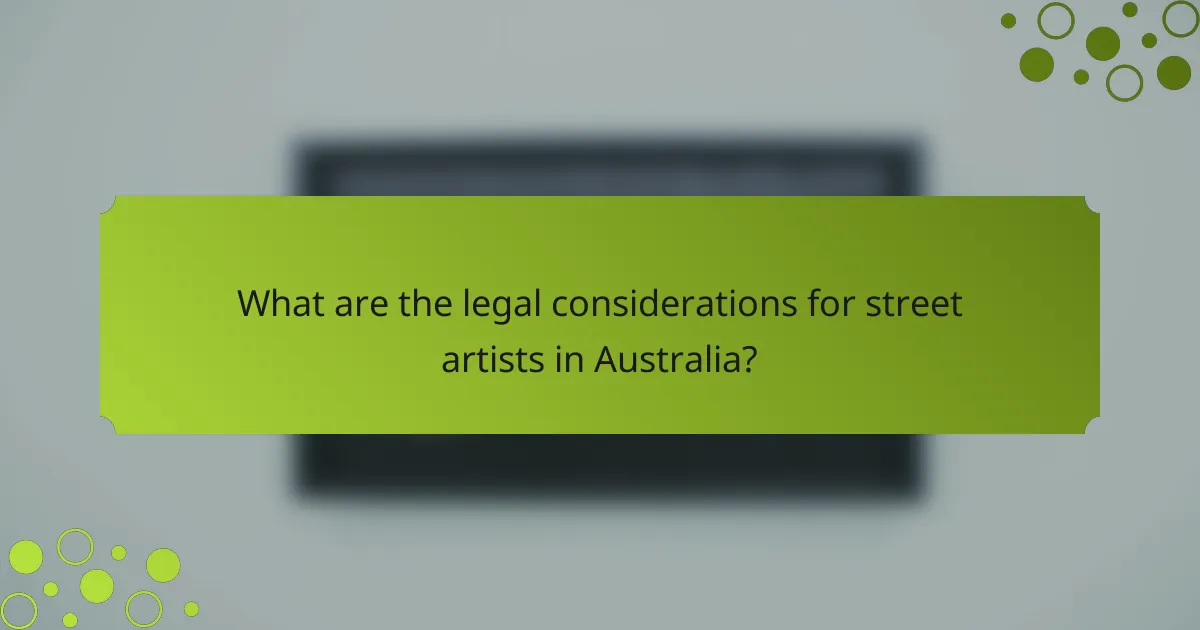
What are the legal considerations for street artists in Australia?
Street artists in Australia must navigate various legal considerations, primarily focused on copyright laws and public space regulations. Understanding these aspects is crucial for artists to protect their work and avoid potential legal issues.
Understanding copyright laws
Copyright laws in Australia protect original artistic works, including street art. Artists retain rights to their creations, meaning they can control how their work is reproduced or displayed.
However, if street art is created on private property without permission, the artist may face legal challenges from property owners. It’s essential for artists to obtain consent before painting on private surfaces to avoid copyright infringement claims.
Permits and public space regulations
In Australia, street artists often need permits to create art in public spaces. Each local council has its own regulations regarding public art, which can include restrictions on where and how art can be displayed.
Artists should check with their local council to understand the specific requirements and obtain necessary permits. Failing to do so can result in fines or removal of the artwork. Engaging with community programs can also provide opportunities for legal street art projects.
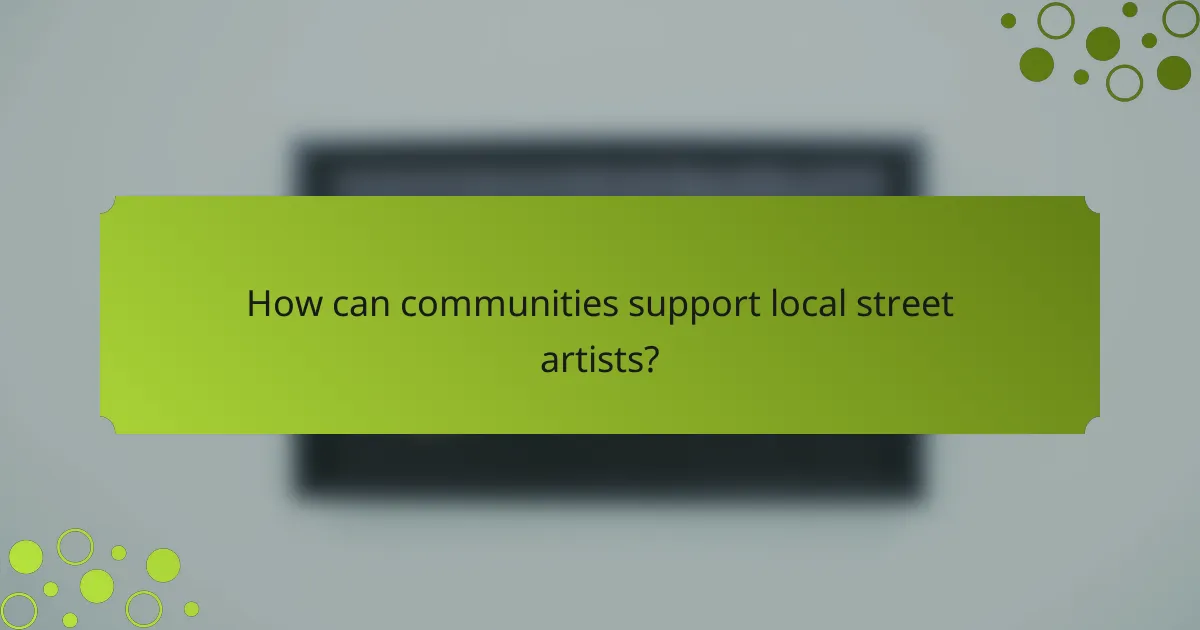
How can communities support local street artists?
Communities can support local street artists by providing platforms for their work and fostering an environment that values public art. This can be achieved through organized events, funding opportunities, and collaborative projects that engage both artists and residents.
Organizing mural festivals
Mural festivals bring together street artists and the community, showcasing their talents while beautifying public spaces. These events often feature live painting, workshops, and community engagement activities, allowing residents to interact with artists and learn about their craft.
To organize a successful mural festival, communities should consider securing funding, partnering with local businesses, and promoting the event through social media. Engaging local schools and art organizations can also enhance participation and visibility.
Creating public art grants
Public art grants provide financial support for street artists to create new works in their communities. These grants can cover materials, permits, and artist stipends, making it easier for artists to contribute to public art projects.
Communities should establish clear criteria for grant applications, focusing on the impact of the proposed artwork and its relevance to local culture. Collaborating with local art councils or foundations can help streamline the grant process and ensure that funds are allocated effectively.
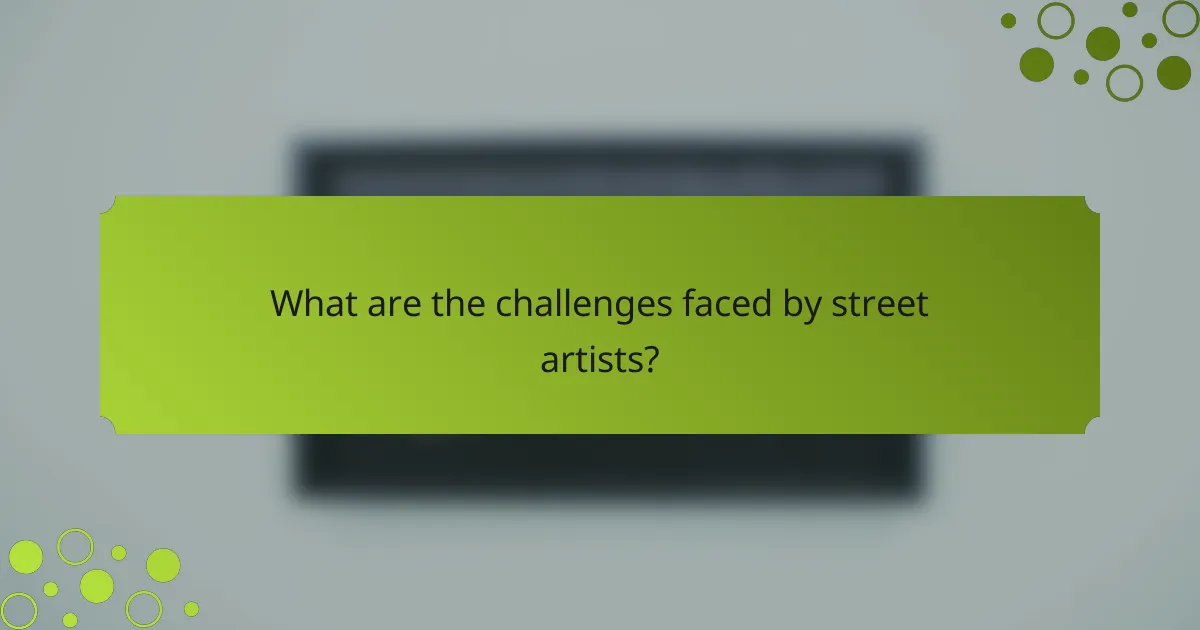
What are the challenges faced by street artists?
Street artists encounter several challenges that can hinder their ability to express themselves and share their messages. Key issues include the risk of vandalism and the removal of their artwork, as well as a lack of funding and resources to support their projects.
Vandalism and removal of artwork
Vandalism poses a significant threat to street art, as many pieces are often defaced or destroyed by individuals who do not appreciate the work. This can lead to a cycle where artists feel discouraged from creating new pieces, fearing that their efforts will be short-lived.
Additionally, local authorities may remove street art under regulations that classify it as illegal graffiti. This removal can happen quickly, leaving artists with little time to document or promote their work before it disappears.
Lack of funding and resources
Many street artists struggle to secure funding for their projects, which can limit the scale and quality of their work. Without financial support, artists may have to rely on inexpensive materials, which can affect the longevity and impact of their art.
Moreover, access to public spaces for creating large-scale murals is often restricted, making it difficult for artists to find suitable locations. Artists may need to seek permission or collaborate with property owners, which can complicate the creative process.
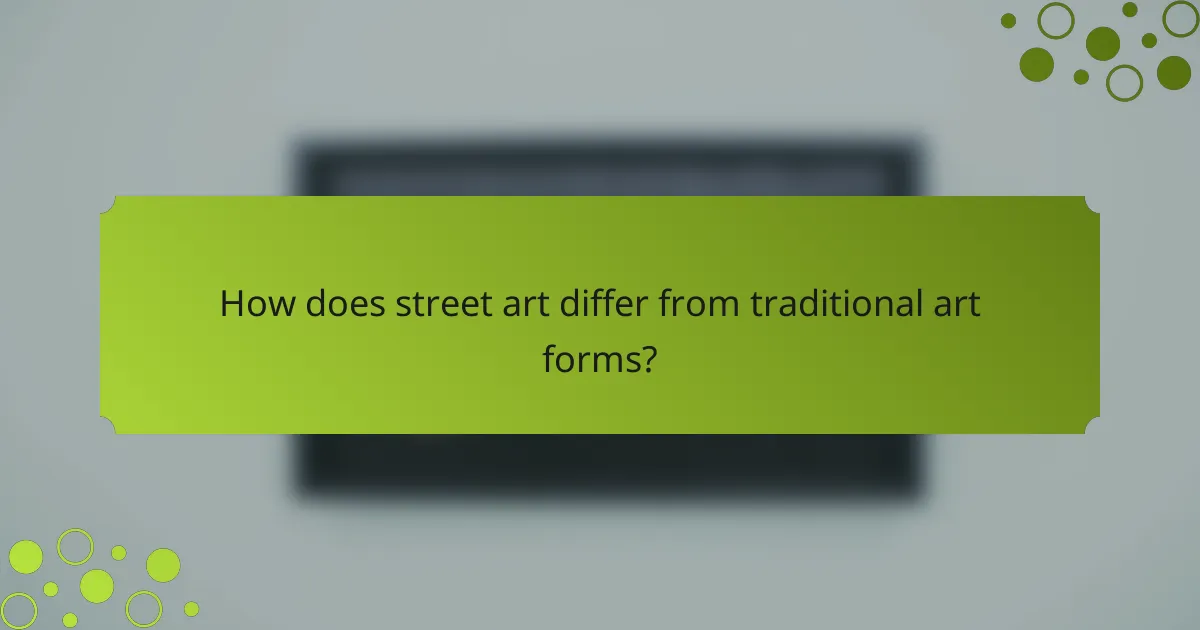
How does street art differ from traditional art forms?
Street art is distinct from traditional art forms primarily due to its public accessibility and often transient nature. While traditional art is typically displayed in galleries or museums, street art exists in urban environments, engaging directly with the community and often conveying social or political messages.
Accessibility and public engagement
Street art is highly accessible, allowing anyone to experience it without the barriers of admission fees or formal settings. This openness fosters public engagement, as people can interact with the art in their daily lives, sparking conversations and reflections on the themes presented.
Additionally, street art often reflects local culture and issues, making it relevant to the community. For instance, murals addressing social justice or environmental concerns resonate with residents, encouraging them to think critically about their surroundings and participate in discussions about change.
To maximize engagement, artists should consider the location and context of their work. Choosing high-traffic areas or collaborating with local organizations can enhance visibility and impact, ensuring that the art reaches a broader audience.
